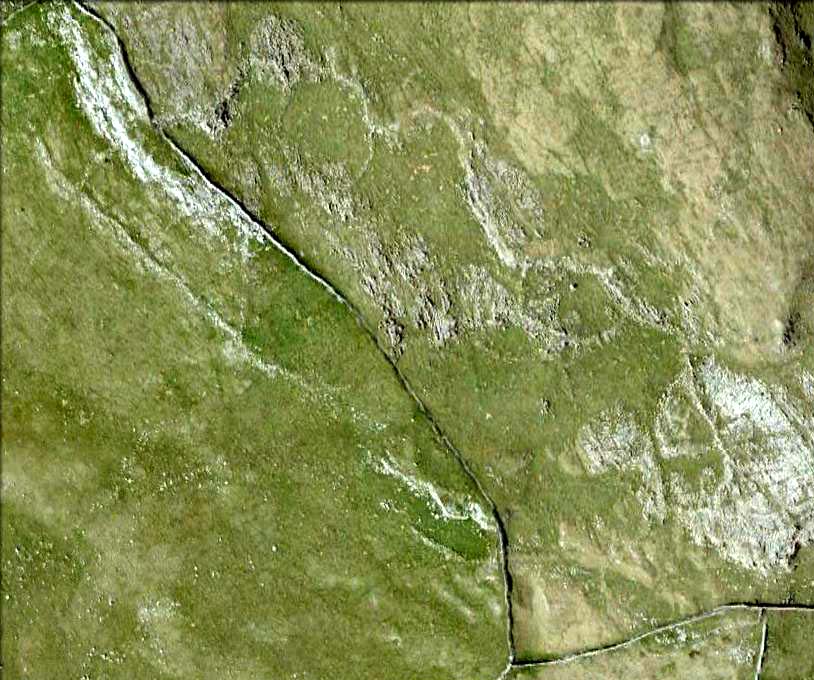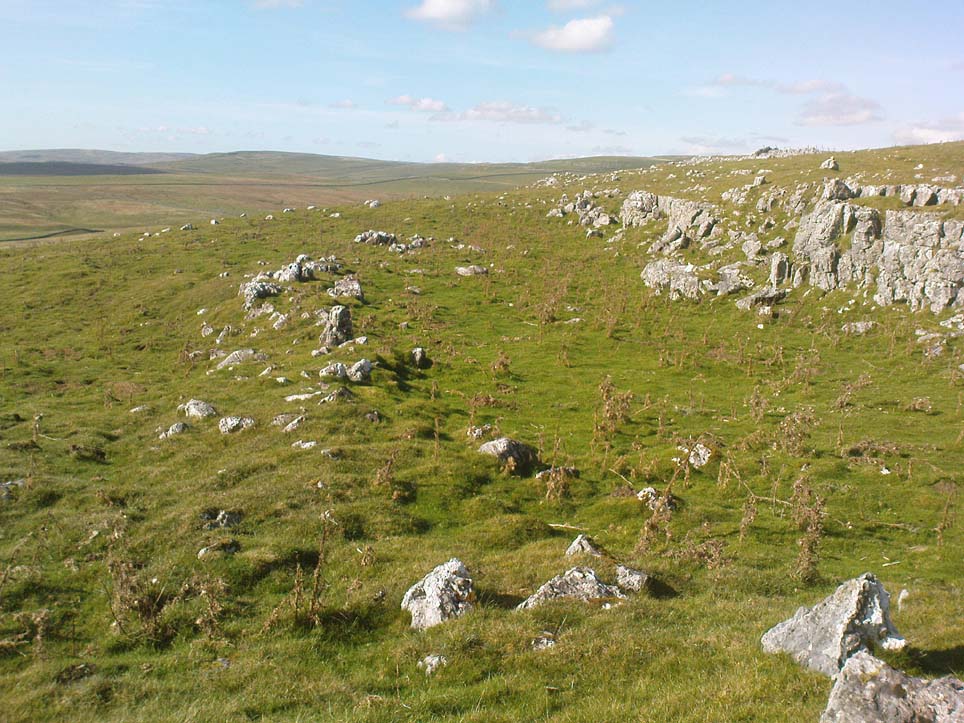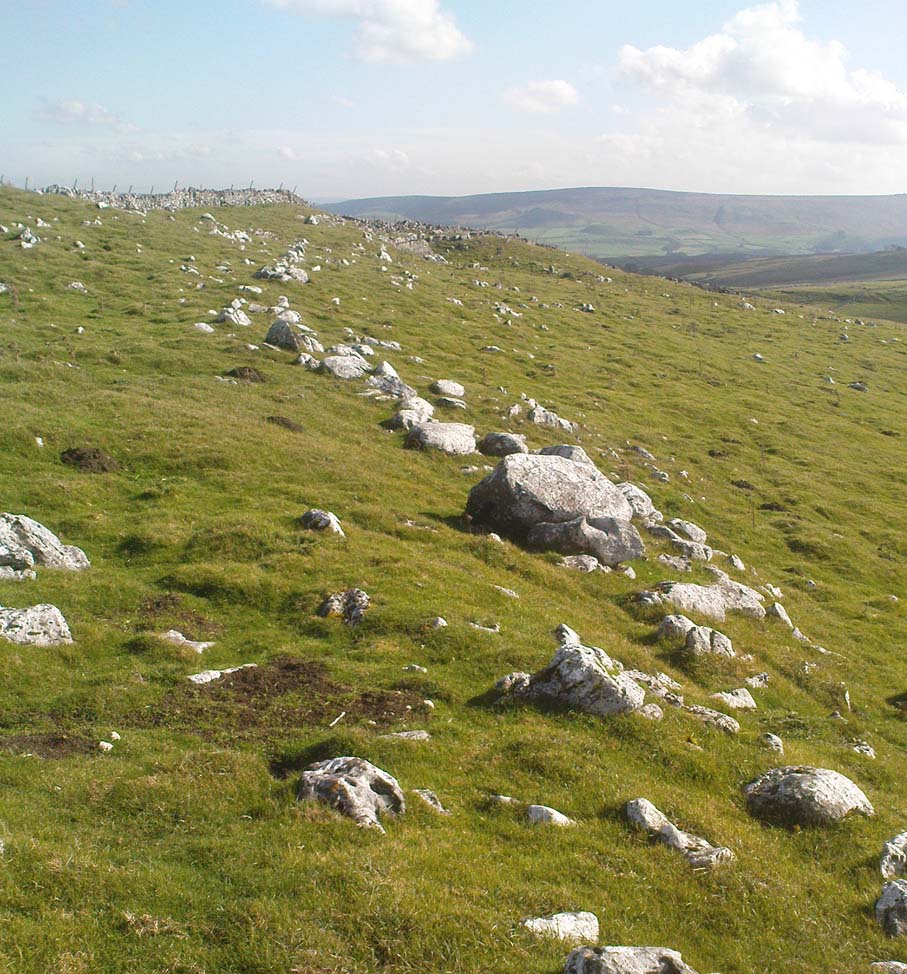Settlement: OS Grid Reference – SD 9528 6574

Follow the same directions to get to Bordley’s Druid’s Altar circle. Where the little rough car-parky-bit happens to be by the cattle-grid, look up the sloping field where the wall runs up in a line and follow it up on foot. A coupla hundred yards up you’ll see a small craggy outcrop in front of you and another line of drystone walling in the corner. Just below this craggy outcrop you’ll notice a raised embankment comprising a line of small rocks running along the edge of the hill. This is the first bitta prehistoric walling that makes up a part of the settlement system. From hereon, follow y’ nose along and up the hill and look around. The settlement’s all around here!
Archaeology & History
This is quite an extensive area of prehistoric (seemingly Iron Age) enclosures on the top and around the edges of the unnamed rocky peak at the top of the large open Lantern Holes field. I’m not aware of any excavation work that may have taken place at this site, so please excuse me of any errors in the description that follows. (if anyone’s got an excavation report of the site, I’d love to read it!)
As with the many other settlements and enclosures in this region, much of it comprises of extensive stonework built up into and against the geological limestone bedrock either side of this hilltop site. Huge lines of prehistoric walling, measuring anything between one and three yards across, runs for hundreds of yards in and around this set of enclosures. We also find several distinct and well-preserved examples of old hut circles (one of which appears to have been re-used as a sheep shelter in more recent centuries) dotted around the edges and in the middle of larger sections of enclosed stone walls. This is all very impressive when you consider it was done a coupla thousand years back!


Very similar in design to the prehistoric settlement enclosures on the other (south) side of the valley at Hammond Close Pasture, above the Druid’s Altar, though more extensive. Measuring roughly 340 yards (311m) along its longer southeast-northwest axis, and nearly 280 yards (254m) from east-to-west, the uppermost parts of the site have at least seven separate large elliptical ‘enclosures’ built within the rocky enclaves, made up of typical Iron Age wall systems: a series of large upright monoliths packed up by smaller packing stones all along the length of the walling (using a system that still prevails today in drystone walling techniques on our upland moors). A couple of the photos here illustrated the walling very well and give you an idea of what to look out for if you’re out wandering the region, looking for old sites.
Although the walling we see today is barren and easy to spot, remember that in the time when people built these great structures, you wouldn’t have been able to see them, as they’d have been deliberately covered over and camouflaged with dressed earth and plants. In watching people emerging from these enclosures, you’d have got the distinct impression that they literally came out of the hill itself: a motif well-known to folklorists in relation to the origin of faerie-folk and other ‘little people.’
We need to go back up here and explore this settlement a bit more, as there’s tons more to be seen. And if anyone knows of any surveys that have already been done of this site, it’d be good to read the reports, preliminary or otherwise. A rough-camping weekend is planned on the tops at the break of Spring – so contact us if you’re into joining us for the amble. I reckon there’s gonna be other sites hidden in the landscape up here that even Arthur Raistrick missed out on!
…to be continued…
References:
- Raistrick, Arthur & Holmes, Paul F., Archaeology of Malham Moor, Headley Bros: London 1961.
© Paul Bennett, The Northern Antiquarian
Paul, the Bordley Township Project are currently mapping this whole area. Last year I spent a few days helping to survey the enclosure you have here. I found a small tool central in the picture to the left. I don’t think any reports have been produced yet though.
http://bordley.kk5.org/#
Hi Rich!
Cheers for that info. Looks a decent project they’re hoping to achieve there. I’ll certainly pass on any of our finds to them.
All the best – Paul
the Bordley Township Project are currently mapping this whole area…I don’t think any reports have been produced yet though.
After contacting them a few weeks ago, and getting a healthy “let’s meet up” reply to explore the archaeological remains of the region – but also a curious “Could you let me have a bit of your (and friends) background please” request aswell (?!?!?) – I’ve just received another email from one of their members (Janice Heward) who tells me that their group have met up, talked, then “discussed this with the YDNPA, whose view is that there is already one community archaeology group involved in this area. The protocol between community archaeology groups is that if one is already involved in an area the others avoid it.” Then a quick remark saying they may share info sometime in the future.
Wot sorta bollox is that about!? If they got an enquiry from Aubrey Burl, or Tony Robinson (Time Team), would they give them the same sorta reply? Yeah…!? Like hell they would! Bloody weird shit if you ask me! Is this becoming common protocol or summat? Especially considering I’m not an archaeology group – and I never said such a thing anyway, specifically telling her: “We are not affiliated with any other official groups, nor archaeological bodies.” So it seems a somewhat bizarre, indeed covert response. If this is gonna become a common response from groups or archaeo’s (it’s the 3rd in a year), their departmental heads & MPs are gonna hear about such protocols. We should have open and free exchanges of data, files, etc, and greater accountability may be heading in the directions of those who keep their information-chests in their own little privy groups.
Has anyone else come across this sorta curious juvenile behaviour in relation to data access within archaeology?